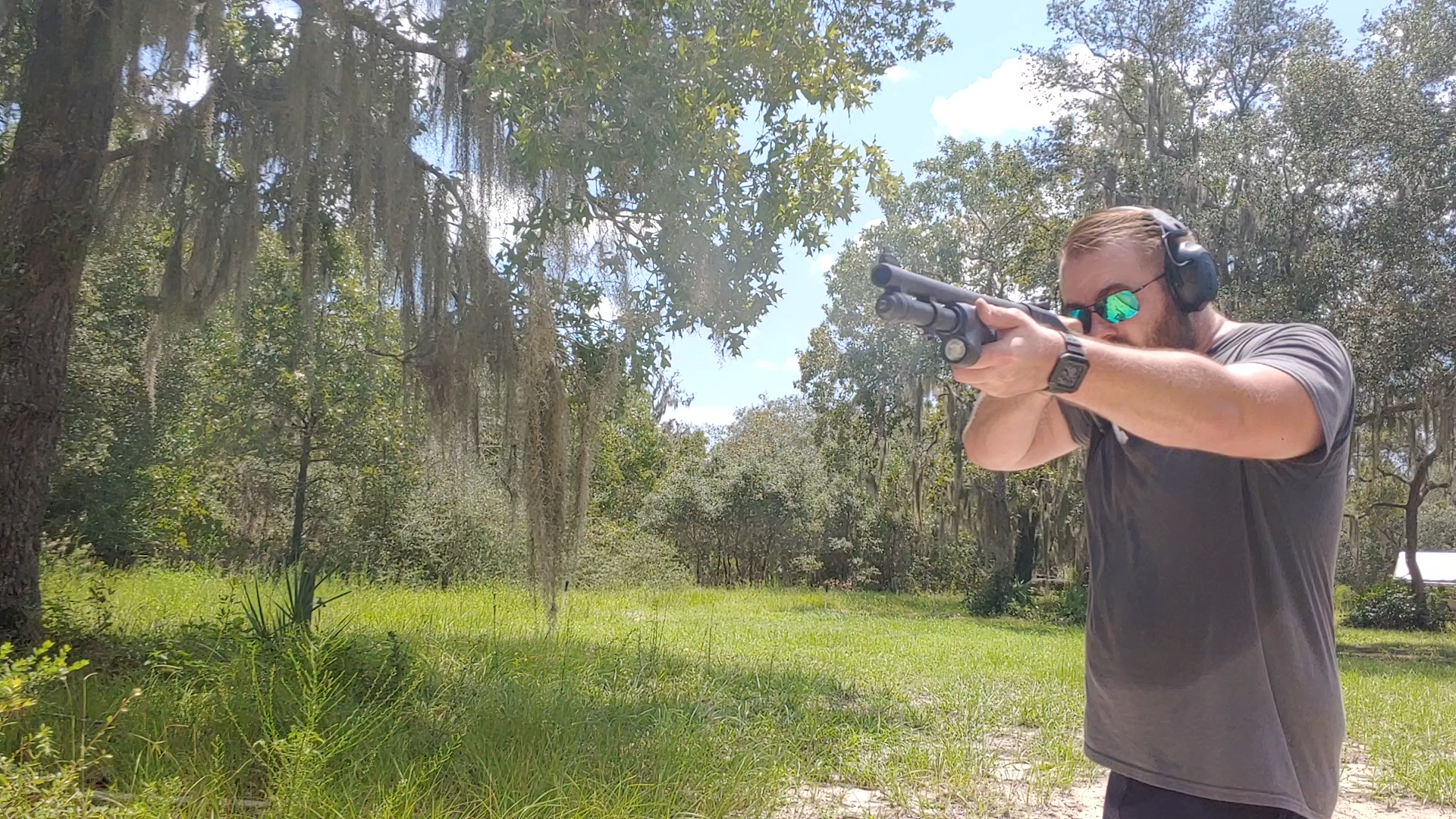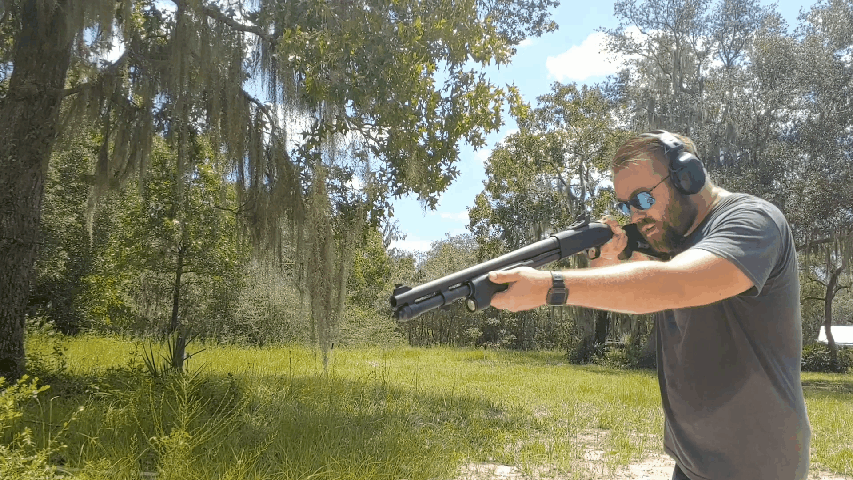Home Defense Shotguns: Light vs Heavy
Travis Pike 09.10.19

For some time I’ve been in the camp that says lighter and simpler is better when it comes to home defense shotguns, and today I wanted to test that. I grabbed two of my favorite shotguns, a timer, a ton of ammo, some clay pigeons, and hit the range.
Looking at the current state of tactical shotguns, we see them tend towards the heavier side. Guns like the Mossberg 590 with its heavy-walled barrel, ghost ring sights, bayonet lug, and 8-shot tube magazine tend to make it tip the scales. Then we might decide to attach lights, side saddles, and more stuff that will weigh it down even more.
Why Lighter is Better
To understand why I believe lighter is better, we should talk about the shotgun’s strengths. The shotgun is a weapon designed for use inside handgun ranges. Home defense shotguns fall firmly into this niche and unlike police and military applications, the use of slugs is not necessary. Within these close ranges the shotgun offers the ability to cause massive trauma to a home invader with just a single shot.

A shotgun can delivers a blast of buckshot to incapacitate most bad guys with a single shot. It’s a weapon that’s quick to get on target because they do not require fine aiming to be effective. This makes it more effective at hitting moving threats as well.
The shotgun offers a significant advantage in a quick moving gun fight, especially if the situation occurs in low light. The shotgun is also an excellent weapon if your home defense plan is just to point the gun at your bedroom door and call the police.
So why is a lighter gun better? You want a shotgun that’s quick and easy to move and allows you to get on target quickly. You also want a gun you can confidently hold up for a long period of time if you are waiting for the police. This makes lighter shotguns more advantageous.
My Home Defense Shotguns
For this test I chose two shotguns. The first is a Mossberg 590 with an 8-round magazine and a Speed Feed stock carrying four rounds of ammunition. This gun is also equipped with a Streamlight TL Racker lighting system. This shotgun also wears Ghost Ring sights and has the infamous bayonet lug. This is my heavy home defense shotgun.

The second shotgun is my 100-dollar Remington 870 Wingmaster. This shotgun has a 4-round tubular magazine, a Steiner MK7 Battle Light, a bead sight, and an AR-style stock and pistol grip. This is my light home defense shotgun.

Both shotguns are shorter guns, and have white lights. I believe a white light is a must-have on home defense shotguns.
For the test I loaded both tubes to the brim. Each tube would stay loaded and I would manually load a round into the chamber for every drill except those which require multiple rounds. My targets are clay pigeons positioned on a berm. I wanted small targets because they require me to aim rather than just pointing and pulling a trigger on a man-sized target. I utilized a Pocket Pro 2 to time each drill.
The Drills
I ran 4 simple drills: snap shots, target transitions, a 3 clay transition, and reloads. I ran every drill but one three times and timed each. Each drill was fired at 15 yards. Ammo used was Federal Flight Control 00 buckshot.
Snap Shots
Snap Shots are simple. I placed a clay at near-head-height on the berm and assumed the low ready with the shotgun, safety on. At the beep I’d raise the shotgun and engage the target. Simple, effective, and important to master. The faster you can go from low ready to hitting a small target the better. Here are the times:
Light Shotgun
- 1.10 second
- 1.08 second
- 1.13 second
Heavy Shotgun
- 1.28 second
- 1.56 second
- 1.29 second
As you can see, the lighter shotgun was faster — sometimes nearly a half-second faster. The lighter home defense shotgun felt more comfortable and natural, especially when I utilized the push-pull method of recoil management.
Target Transitions
For my target transition drills I placed a clay pigeon to the far left of the berm at head height. At the bottom left corner of the range I positioned a concrete block. I’d start by aiming my shotgun at the block and at the timer beep, swing to the clay pigeon and fire.

Light Shotguns
- .90 second
- .87 second
- .88 second
Heavy Shotgun
- 1.12 second
- 1.06 second
- .98 second
Again we see the lighter shotgun faster on target. I also felt a lot more comfortable with the lighter shotgun. The heavier shotgun had much more momentum at the swing and would cause me to swing past the clay.
3 Clay Sprint
The 3 clay sprint consists of three targets placed at different heights and different locations horizontally. I placed one to the far left of the berm at head height, one to the far right at belly height, and the final one at calf height on the far left. It was a fun challenge and a drill I enjoyed quite a bit. Due to constraints on my time, ammo, and targets I only ran this drill once with my home defense shotguns.

Light Shotgun: 2.32 seconds
Heavy Shotgun: 2.97 seconds
Once more, our light home defense shotgun excelled by more than half a second. Again the transitions were quicker and I felt I could put my shots exactly where I wanted them. The heavier shotgun felt clumsier to move with.
Reloads
Reloading the shotgun is a valuable skill. It may not be important for 95% of shotgun gunfights, but if it is necessary you want to be able to run with it. I started with each gun with empty tubes, and one round in the chamber. On the timer beep I’d load two rounds from my plate carrier into the magazine and fire the round in the chamber. Once the round was fired, the drill is over.
Light Shotgun
- 4.67 seconds
- 4.21 seconds
- 4.36 seconds
Heavy Shotgun
- 5.58 seconds
- 5.44 seconds
- 5.87 seconds
Here we see the biggest difference between the two guns. Reloading the lighter shotgun and then getting on target was much easier. The lighter shotgun was easier to hold up with the barrel pointed downrange. The heavier of the home defense shotguns dipped due to its weight.
Home Defense Shotguns and Science
I know there are many better shooters out there who could pick up that heavy Mossberg and make music with it much faster than me with my lighter shotgun. However, I’m betting that same skilled shooter could do better with the lighter shotgun than the heavy one.
It’s much more comfortable, much easier to mount, and quicker on target. Being quicker on target is critical when it comes to a shotgun. The faster you can get on target the faster you can end the fight.
The downsides are mostly tied to the fact the Mossberg has twice as much ammo in the tube. The big question I have is, is that extra ammo necessary? The shotgun as a weapon isn’t suited for high round count firefights, and a lighter shotgun is a faster shotgun. The faster you get a round of buckshot on target the quicker the fight will be over.
What are your thoughts? Did I make any flaws in my testing? What drills should I add? Let me know below.

